Revision
Y10 Revision Seminar 2025
Revision Strategies
PART 1
3. Revision Clock Presentation
5. Card Sort and Trigger Lists
Revision Methods and how to use them
PART 2
1. Producing a Revision Timetable
3. Memory Clock
5. Get Creative
Revision Reel
Below are revision strategies from our students, starting with an example. Revision Reel will promote, educate and engage students in different revision strategies.
The content here will increase through the academic year.
Revision Day
Y7-13 have taken part in a revision day to support future assessments and life-long learning. During this day, students explored the theory of learning and memory with the emphasis on retrieval practice. Students were taught 7 strategies underpinned by cognitive science to support the retention of knowledge. This was further supported with a parent webinar, thank you to all that attended. If you could not make the webinar or would you like to access this session again, please find a link to the recording below.
Webinar_ Revision Strategies and the Importance of Retrieval Practice-20211019_190017-Meeting Recording:
Links for resources:
Revision Clock Template:
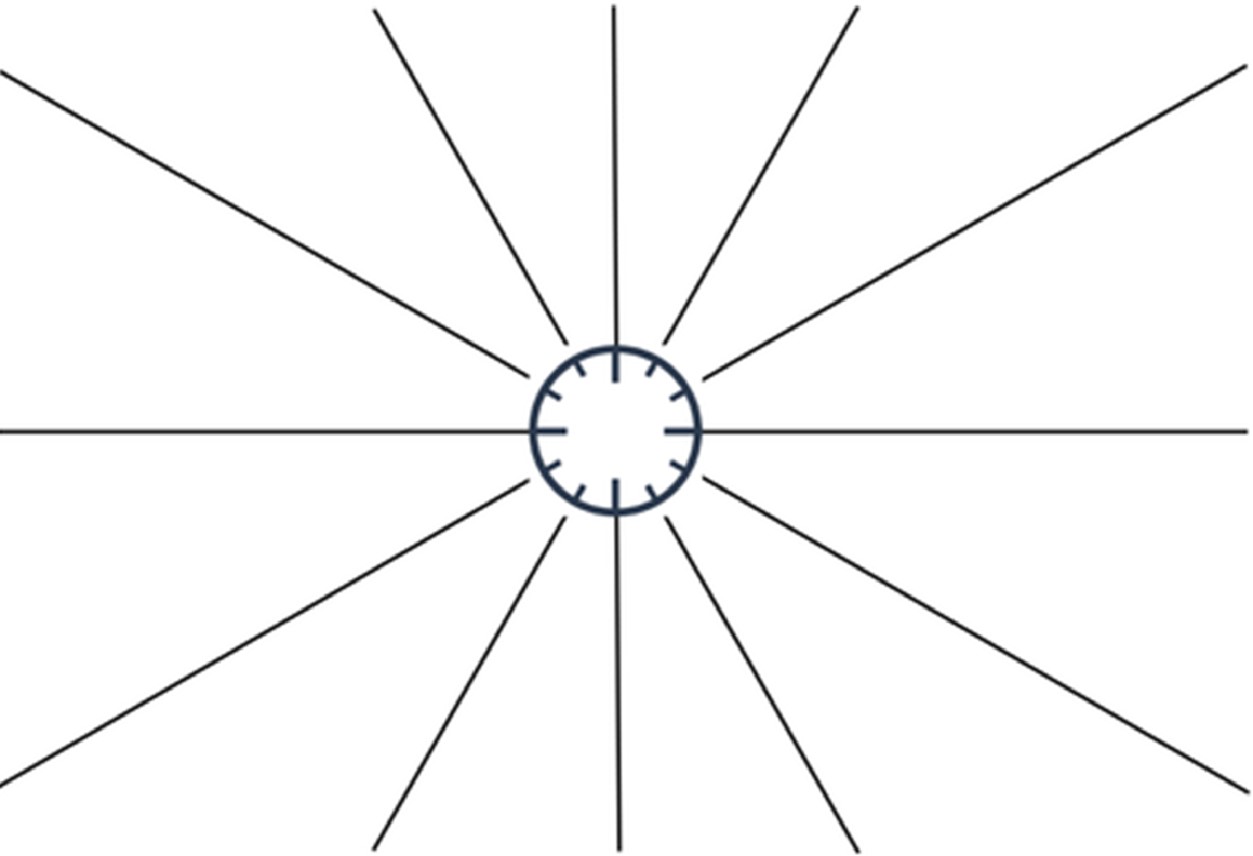
Toolkit for Modern Life referred to in the webinar:
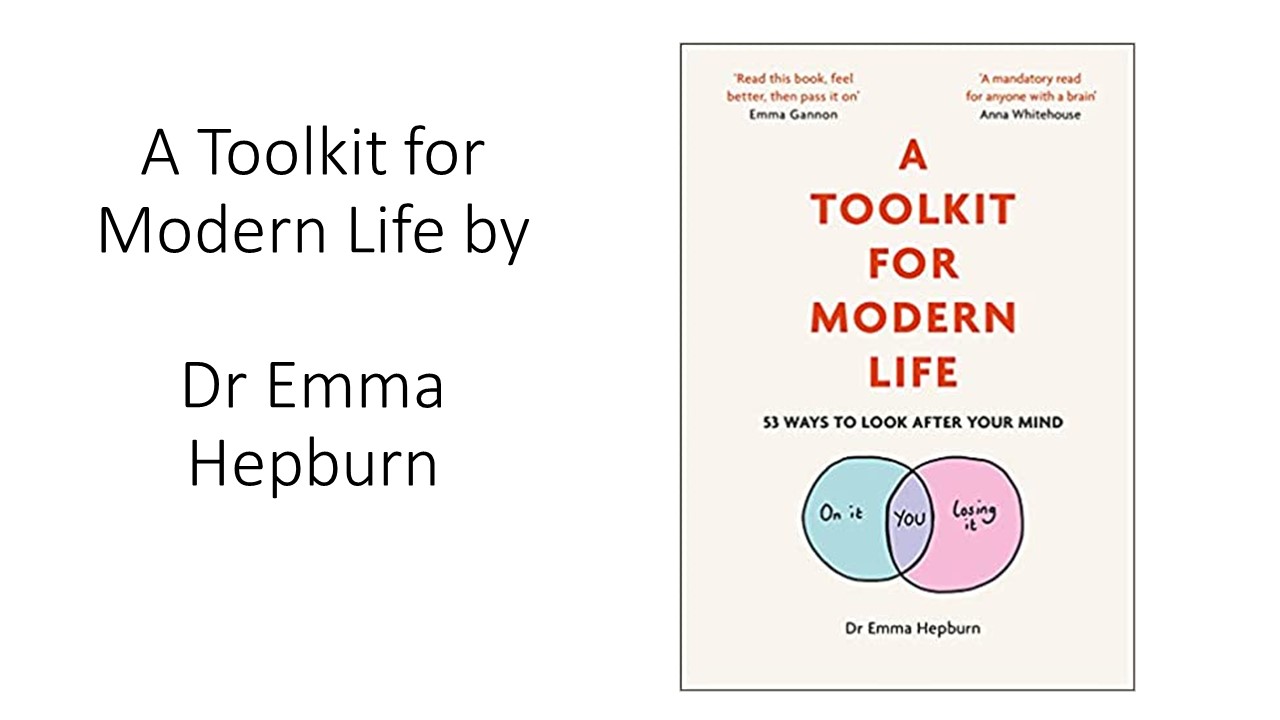
Revision and Study Skills
C.R.A.V.E.
Creativity - The more creative your strategies the better and more enjoyable.
Repetition – You will need to cover content multiple times before you can remember it. Organisation is key to this, so you use your time efficiently.
Activity – Try and make your learning as active as possible. Friends and family working with you can be even better. Visual – Use visual aids (pictures) to link with keywords.
Environment – Quiet and organised with all the equipment you need. No smartphones when working. Manageable chunks of time (25 mins work, 5 mins rest ‘Pomodoro Technique’ www.mindtools.com) Also get some quality sleep & rest
Scanning & Skimming
These techniques can be used to find information quickly and to prioritise information when reading text. You will not always have the time to read everything in detail during your revision.
-
Scanning is used to find a specific word, phrase or piece of information.
-
Skimming is used to find out what the text is about – ‘to get the gist’.
How to Scan:
-
Try to decide beforehand what information you want to find out.
-
Don’t try to read every word. Instead let your eyes move quickly across the page until you find what you’re looking for.
-
Use clues on the page, such as headings and titles, to help you.
-
Look out for words highlighted in bold or underlined.
-
With longer books, use the chapter list or index system.
How to Skim:
-
Read the title, subtitles and subheadings to find out what the text is about.
-
Look at the illustrations to give you more information about the topic.
-
Read the first and last sentence of each paragraph.
-
Don’t read every word or every sentence. Let your eyes skim over the text and look out for keywords.
Example of ‘Skimming’
By just reading these key points from the text it would be possible to work out if the article is relevant to the student without reading the whole text (the rest of the text has been blanked out). If it was relevant then the student could stop and read it in more detail and then use it within an active revision strategy.
Reading alone is NOT effective revision!
Getting creative is often the best way!
Some simple ideas for making your revision more active by using information in other ways to help encourage deep processing! Deep processing helps your brain embed the concepts into long-term memory.
| Superficial Strategy (doesn't work) | Deeper Processing 'Better' strategy (does work) |
| Read p7 | Look at page 7 and find the most important piece of information. Tell someone what you think, and why. |
| Watch a 5-minute video clip | Watch a 5-minute video clip and then discuss the main points with someone, or summarise the information on 1 side of A4 paper. |
| Watch a video and at the end describe what you have seen | Watch a video and at the end describe what you have seen as if you are talking to someone who has lost their sight (greater detail) |
| Copying down keywords for topics | Copy down keywords and link with small pictures (visualisation) |
| Answer old questions on topics | Create your own new questions and then produce model answers for them. |
| Answer questions in relation to text/video | Create a new list of questions in relation to text/video |
| Do 10 calculations | Find 20 calculations, do the 10 hardest for your ability |
| Read a paragraph | Read a paragraph and reduce to one single sentence/word |
| Read a story | Read and identify key character, event or turning point |
| Summarise page | Summarise page in no more than 150 words |
| Read an article | Read it and imagine you have been asked to edit so as not to lose the meaning, what would you cut out and why? |
| Reduce paragraphs down to 10 key words | Reduce paragraphs down to 10 key words Now reduce this down to 5 key words, now reduce this to 1 key word |
| Change information into a flow diagram |
Change info into multiple forms:
|
| Explain how something works | Use other materials to model or act out how something works |
| Explain a concept | Create an analogy. It's bit like... |
| Prepare and deliver a presentation on something | Prepare and deliver a 40 second presentation on something |
| Summarise a topic by doing mind maps | Summarise a topic by doing a mind map on A4 paper (if you were allowed to take just this sheet into the exam what would you write?) |
| Explain a concept e.g. An Earthquake |
Explain what causes an earthquake? You may not use the words: tectonic plates, pressure, fault line, energy etc. |
Why are mind-maps useful?
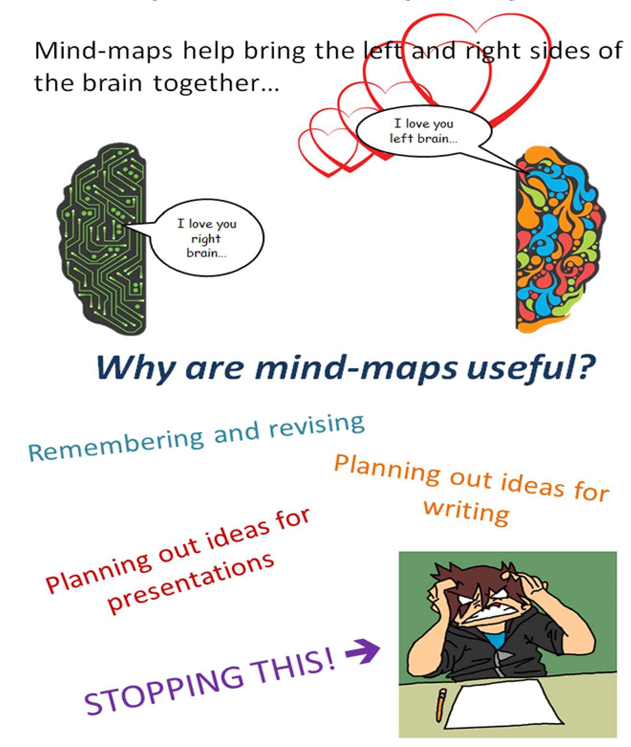
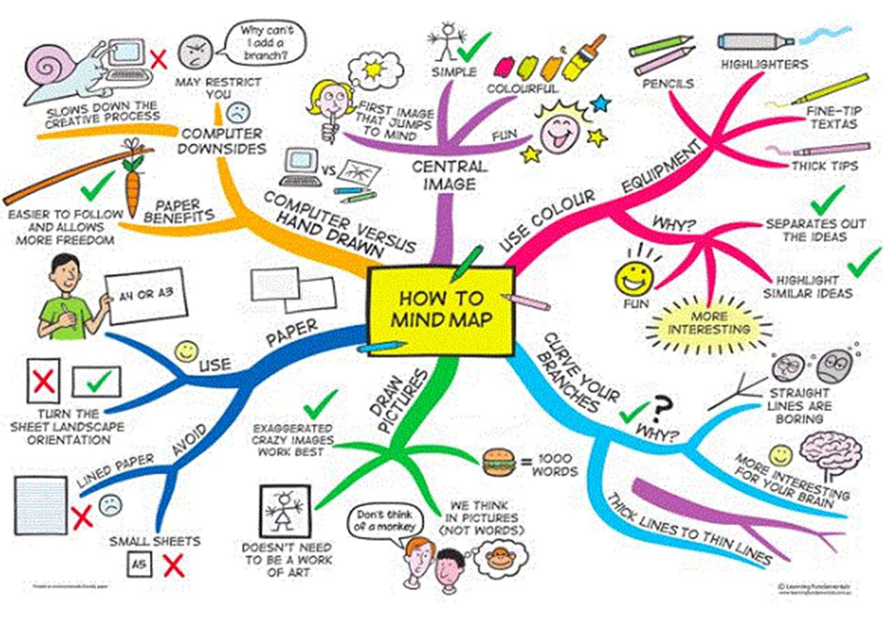
Doing Things Over and Over Gets The Best Out Of Your Memory
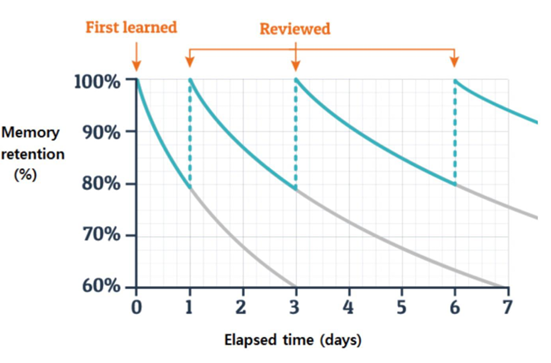
The is the forgetting curve proposed by Ebbinghaus, who studied memory over time. If you look at the first line (left). This is the day a student learns something, at that moment in time, as they leave the classroom, they can recall almost 100% of the information learnt. However, by day 2, the information recalled has dropped by at least 30% and this continues to drop over time.
Our memory does not retain the information if we do not regularly use it. By a week later, the learning from day 1, if not reviewed is very difficult to recall and students will have forgotten a significant amount. However, with regular review (revision), more information is retained in the memory, indicated by the other lines. Meaning, it is easier to retrieve.
Every time a student revises and reviews, the quicker and easier it is to recall and the greater the understanding.
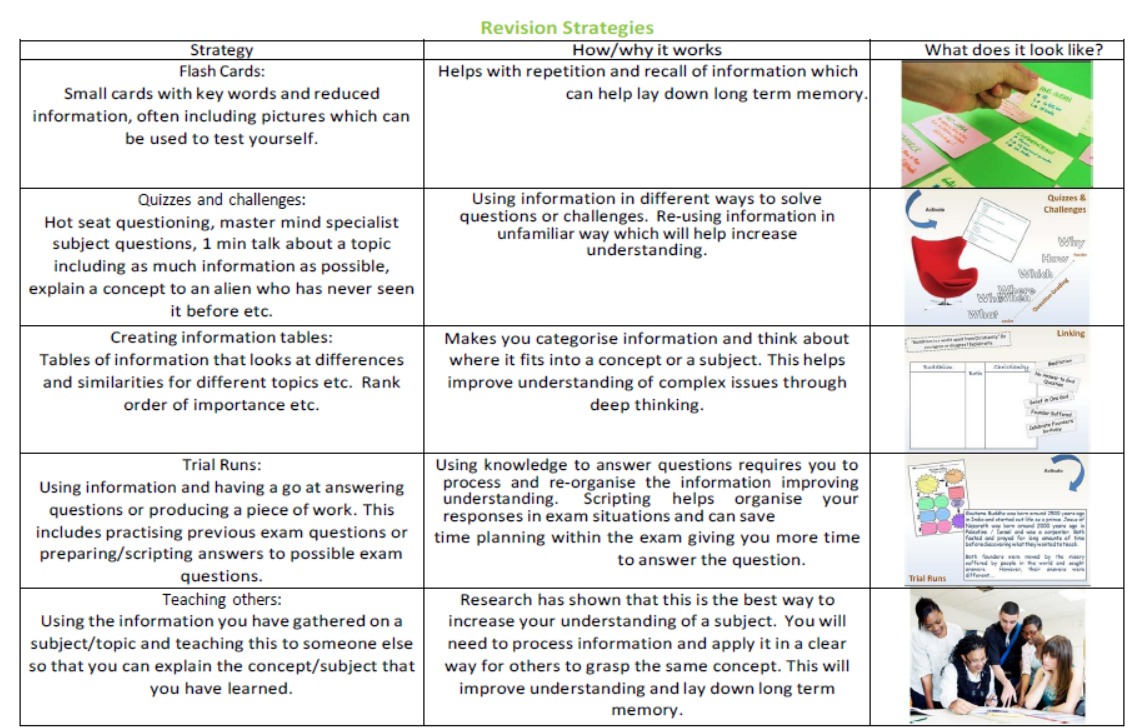
Visualisation and Linking
Visualisation and linking is a very powerful way of improving memory re‐call. This technique involves linking pictures to key words or concepts so that you can help remember them when asked to re‐call the information.
E.g. A Law student is asked to remember the following legal case information:
Donoghue v Stevenson 1932
This case was a foundational decision in Scots delict law and English tort law by the House of Lords. It created the modern concept of negligence, by setting out general principles whereby one person would owe a duty of care to another person. Also known as the "Paisley snail" or "snail in the bottle" case, the facts involved Mrs Donoghue drinking a bottle of ginger beer in a café in Paisley, Renfrewshire. A dead snail was in the bottle. She fell ill, and she sued the ginger beer manufacturer, Mr Stevenson. The House of Lords held that the manufacturer owed a duty of care to her, which was breached, because it was reasonably foreseeable that failure to ensure the product's safety would lead to harm of consumers.
This is a lot of information to remember in the exam so they decide to link the keys words from the case with a picture to help them remember.
The Law student creates the following visual representation of the case:

This is all the information the Law student needed to re‐call that the case was Donoghue v Stevenson 1932 where Mrs Donoghue had drank from a ginger ale bottle and became ill and she therefore sued the company for negligence. The judge decided that the manufacturer Mr Stevenson had not ensured the safety of their product and so Donoghue was successful in her case.
This technique can be used for any subject to help remember facts and then re‐call this information later. You don’t have to be an artistic genius, the simpler the pictures the better. Try using small pictures linked to keywords and put all the keywords for topics with small pictures on no more than one side of A4 paper per topic. This technique can also be used in Mind Maps to very good effect.
Useful revision websites
www.getrevising.co.uk/
Get revising has a good online study planner and loads of resources for individual subjects.
https://senecalearning.com/en-GB/
A word of warning about GCSE Bitesize!
http://www.bbc.co.uk/schools/gcsebitesize/
BBC GCSE Bitesize has lots of information for individual subjects. However, it has recently been archived and is no longer updated. Therefore, be careful as new specifications will differ in subject content!
Knowledge Grids
Creating grids with all key words and information for a topic is another way of organising and revising. The example below covers all base knowledge Geometry concepts.
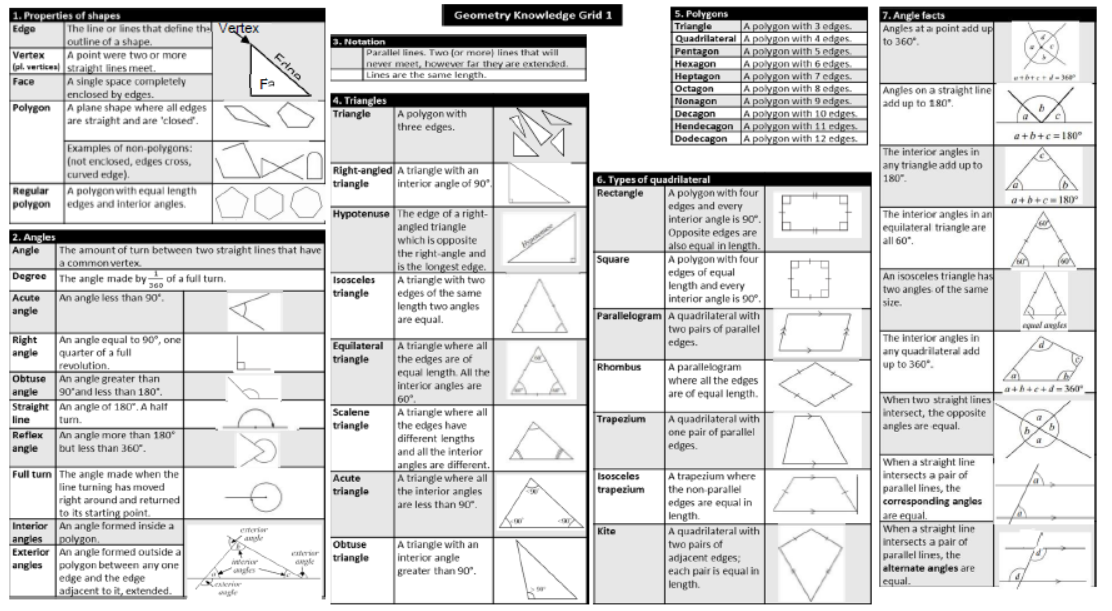


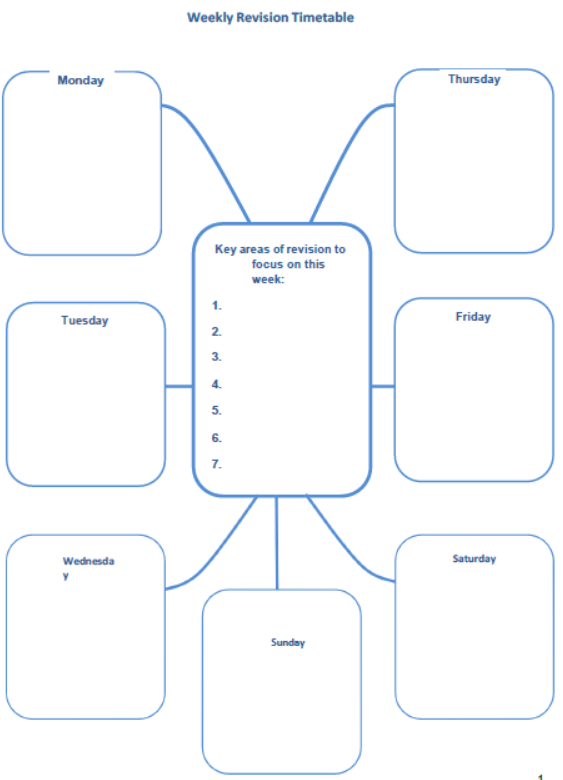
OTHER MEMORY TECHNIQUES
-
ACRONYMS - e.g. SPORT (Specificity, Progression, Overload, Reversibility, Tedium)
-
MNEMONICS - e.g. Richard of York Gave Battle in Vain. (colours of the rainbow)
GOOD WEBSITES CAN MAKE REVISION ACTIVE
- www.gcse.com
- www.s‐chool.co.uk
- www.studystack.com
- www.quizlet.com
- www.linguascope.com
- www.mymaths.co.uk
DURING THE REVISION PROCESS
- Little and often.
- Regular breaks.
- Food and water.
- Do something different – go for a walk.
- Good sleep pattern.
DURING THE EXAMINATIONS
- Do not listen to those who claim they are doing no revision…they are probably exaggerating their lack of work.
- Check the examination timetable for dates and times.
- Adjust revision focus linked to when the exams are taking place. You may need to spend more time on those subjects you have first in the early part of your revision timetable.
- Serious problems? – Talk to a teacher.
EXAMINATION PREPARATION
Now that you know how you think and have guidelines to help you learn.
You cannot revise effectively if you don’t have all the information you need so…
- GET COPIES OF THE SPECIFICATIONS. Make sure you have a copy of the specification for each of your courses so you know what you need to know. Your teacher may have given you one.
